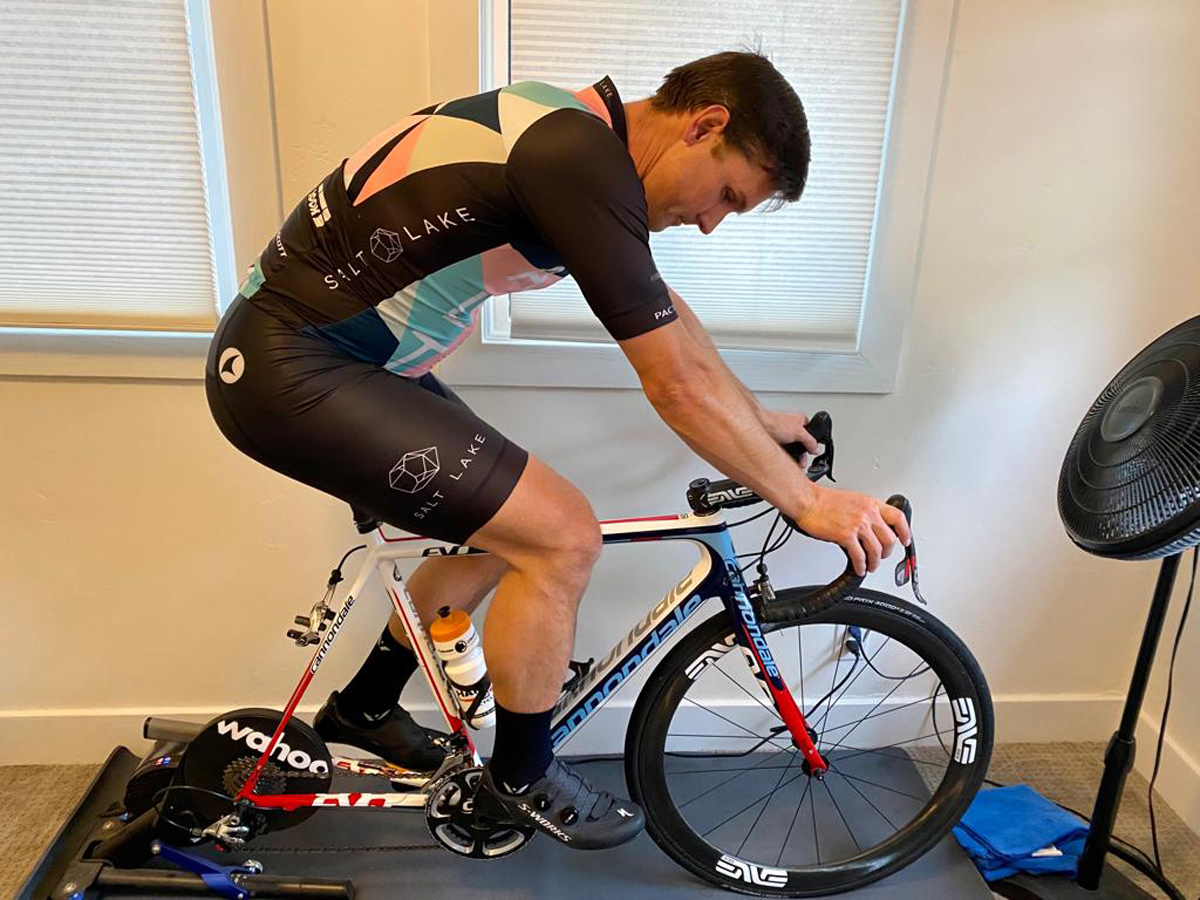By John Higgins — The first snowflakes of winter are hitting the valley floor as I write this — meaning more of you will likely be riding your bike on a trainer inside over the next few months. Or you might have upgraded to an indoor exercise bike from Stages or Wahoo to save your outdoor steed for, well, outside!
There are some obvious differences between riding inside and riding outside. One difference that many people notice is that for some inexplicable reason, they are less comfortable. This can be perplexing if you feel great on your bike outside, but less so inside. Maybe your hands are going numb, or the saddle is speaking up loudly. What’s up with that? There are some interesting physics going on. You’ll also warm up and get hot real fast. Hence the need for a cool room and a well-directed fan.

Let’s start with the heat. Although you think all those calories you are expending are going directly to the pedals, cyclists only have an energy efficiency of 20-25%. Less than a quarter of your effort is reaching the pedals, and the rest of it is lost as heat. Without the evaporative cooling effect of moving at speed through air outside, you will quickly ramp up the humidity of your training environment and your body will try to lose heat through increased and obvious sweating. To mitigate this, do as much as you can to keep the room cool; open a window; have one or two fans going; have hydration at hand, and consume it; and have a hand towel to mop yourself off. Also dress lightly. Consider liner shorts instead of regular bibs or shorts, as they offer a more open weave and better ventilation. You are trying to reduce “swamp crotch”. No need for a cycling jersey. The less the better up top, depending on the privacy of your training environment and need for support and modesty, or propensity to livestream your workout.
The disappointingly little energy that does reach the pedals is used to turn the cranks, which move the chain, which rotate the wheels, which – in the outside world (or on rollers), dissipate that energy into forward momentum. In the inside world on the trainer, that energy is not dissipated, but circles back to bite you in the butt. Ouch! It’s not lost to the road through momentum and the movement and sway of the bike underneath you. On a stationary trainer or exercise bike that is held and supported rigidly and upright there is no forward momentum, nor much side-to-side movement. Also, because the need for balance is much reduced and you don’t need to steer, corner, or brake, your core is likely to be less engaged and active. This combination of factors tends to concentrate and magnify any mis-fit in the bike – body relationship. Because of the way energy is dissipated while riding outside, minor issues can be masked by the more dynamic nature of riding on roads and trails. It’s not that these issues don’t exist, but they are being dulled or absorbed. But inside on a trainer they can be highlighted and brought to the fore.
An increasing recognition of this issue has led to the creation of DIY and commercial “rocker plates” and other trainer accessories. These contraptions go under your trainer and provide for more “realistic cycling movements”. The bike will move back and forward and side to side in response to your efforts. It’s doing this all the time when you are riding outside, but because it is “normal” you don’t really notice it. What you notice is when this is not happening, which is most of the time inside. There are also some trainers that allow this movement to take place, like the Kinetic Rock n Roll, which I use in my fit studio.
If feet, saddle pressure, back, shoulder, neck, or hand issues are bothering you when riding inside, but not when you are outside, you might want to consider having your bike fit revaluated and refined, and / or look into the rocker plate revolution. Indoor cycling, training, and racing may involve a bike-like object and turning the pedals, but it is a different sport with different physics at work. Understanding the differences can help you optimize your experience and crush your rivals on Zwift, enjoy the scenic rides on Rouvy, or knock out your TrainerRoad workouts with increased satisfaction. Ride on!
John Higgins is a professional bike fitter and purveyor of unique and boutique bicycles and fit-related components and accessories in Salt Lake City. More info on bikefitr.com

